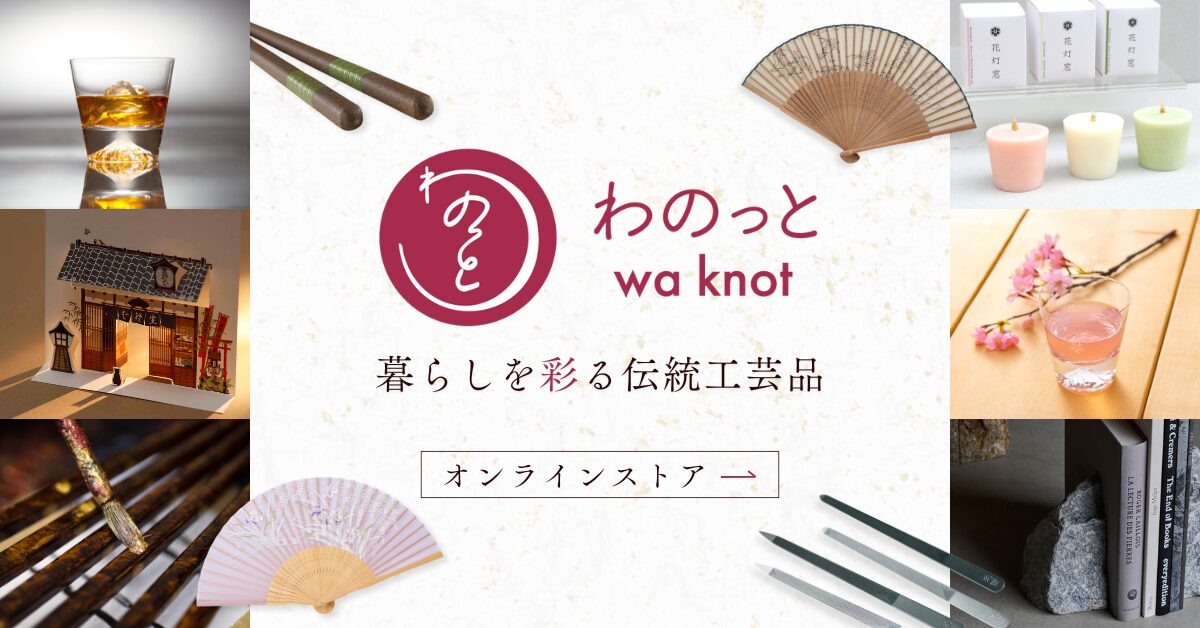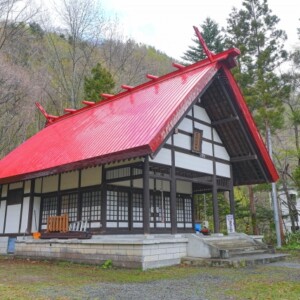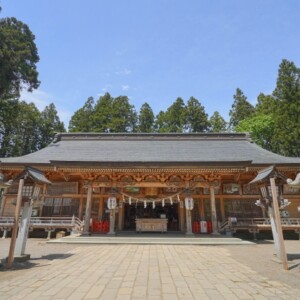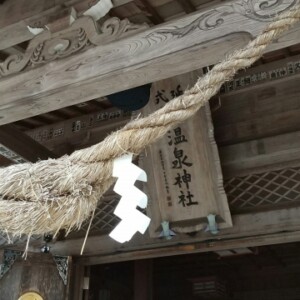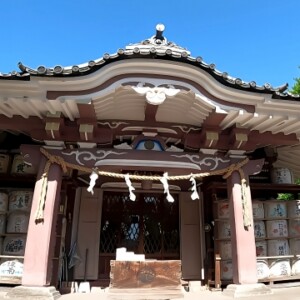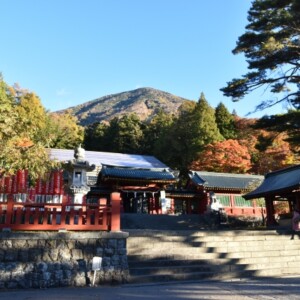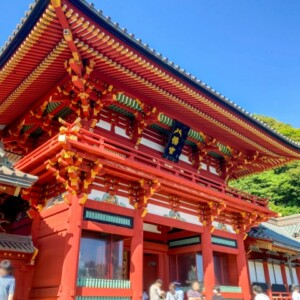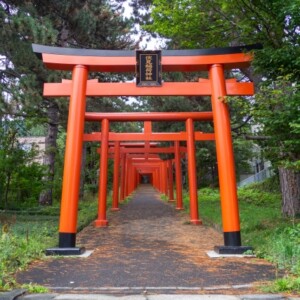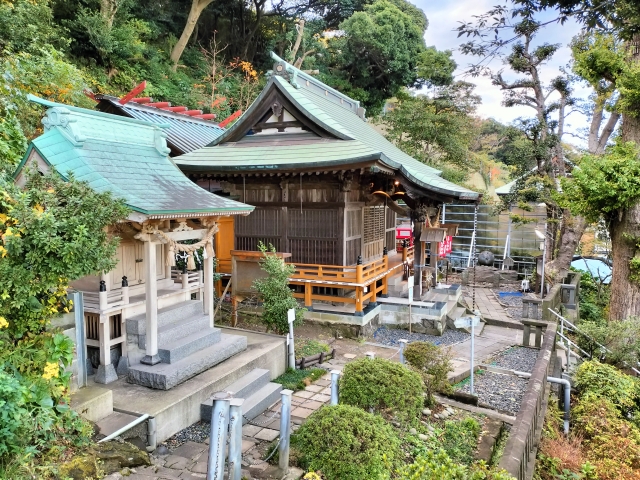
Housui-jinja Shrine|Complete guide to the history, highlights, and worship information of this historic shrine
Sosui Shrine, located in Yokosuka City, Kanagawa Prefecture, is a historic shrine dedicated to Nihonmusonon and Ootachibanahime-no-Mikoto. The shrine is a sacred place where ancient legends, recorded in the Kojiki and Nihonshoki, come to life, attracting many worshippers along with the beautiful scenery of Tokyo Bay.
Outline and basic information about Hashimizu Shrine
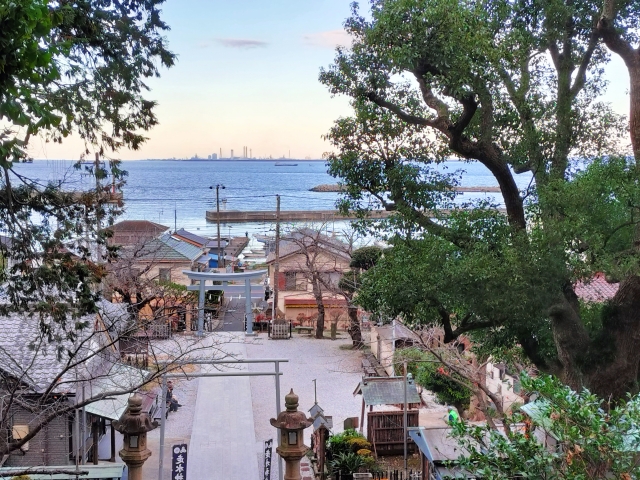
Hashimizu Shrine enshrines two deities, Nippon Musunonushi, the son of the 12th Emperor Keiko, and his consort, Otokachanahime-no-Mikoto. It is located near the eastern tip of the Miura Peninsula, facing Tokyo Bay, and is known as a sacred place with a long history, whose name is mentioned in the Kojiki (Records of Ancient Matters) and Nihonshoki (Chronicles of Japan).
The name of Suisui is already mentioned in the Kojiki (712) and Nihonshoki (720), and during the Yamato period, the Ko-Tokaido Highway ran through this area as the most convenient route to the Tohoku region via Kamisusa (Chiba Prefecture). Today, it is also one of Yokosuka’s most popular power spots, and is especially popular among female worshippers.
History and Origin
The exact date of the shrine’s founding is not known because the shrine’s records and treasures were destroyed by fire during the Kyoho period (1868-1868). According to legend, in the 40th year of Emperor Keiko’s reign (110), when he was ordered to conquer the eastern barbarians, he gave a crown to the villagers when he crossed from Hashimizu to Kamisusa.
When the god Nippon no Mutsuon attempted to cross to Kamihisa Province by warship, a strong wind suddenly blew and the sea became stormy, and the warship was caught in the waves, making it impossible to go forward or return. At that time, Princess Ootachibana Ehime left behind a poem, “Sane-sashi sagamu no onu no yuwu hi no honakani tachitate tohishikimimimo,” and threw herself into the sea to calm the wind and waves on behalf of Nippon no Muson.
Gods and Benefits
The deities of the shrine are Nihonmusonon and Ototachibanahime-no-Mikoto. Nihon no Musunon is known as the superhero of Japanese mythology who conquered the western and eastern provinces of Japan, and is worshipped as the god of bravery and national security. On the other hand, Otachibana Ehime is revered as a symbol of devotion and love who sacrificed her own life to save her husband’s, and as a god of femininity, conjugal harmony, and maritime safety.
In particular, the spirit of self-sacrifice of Princess Otsuchibana Ehime is believed to be a power spot for learning true femininity, and many female worshippers visit the shrine for its benefits to “increase women’s power”. It is also known as a place of good fortune for maritime safety and traffic safety, as she threw herself into the sea to protect the safety of voyagers.
Highlights and Features of Hosomizu Shrine
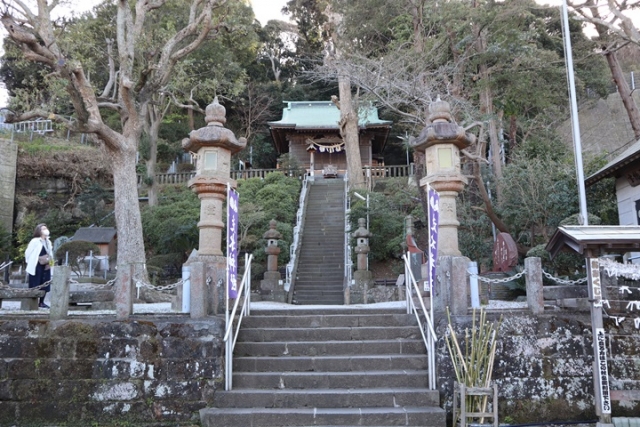
Hashimizu Shrine is a shrine with a wealth of attractions, where buildings of great historical value are harmoniously combined with a beautiful natural environment. The shrine grounds are dotted with numerous historic sites that tell ancient legends and deeply impress visitors.
Architectural and Structural Attractions
Visitors enter the shrine grounds through a torii gate close to the sea, and climb the stone steps at the end of the straight approach to the shrine, where they will soon find the main hall. The main hall maintains the beauty of traditional shrine architecture, while taking advantage of its location on a hill overlooking the sea to create a majestic appearance.
There are also several shrines on the grounds of the shrine. Mizujinsha, located to the far right of the main shrine building, is a shrine dedicated to the worship of water. The legend of kappa, or kappa incarnating water, still remains in the area, and it is said that kappa helped people in distress and guided them through the fishing industry, bringing in large catches of fish. In addition, three shrines, Shinmeisha, Suga Shrine, and Suwa Shrine, are enshrined on the hill behind the shrine, and the area is known as a power spot surrounded by a sacred atmosphere.
The spring water in the water closet is fresh water containing minerals that gushes out from a depth of 30 m. It is said to have gushed out in this area over a long period of time from Mt. Fuji. The water was used as drinking water for ships in Hashimizu, which prospered as an inn town, and there is a theory that the abundant underground water is the origin of the name “Hashimizu”.
Nature and scenic beauty
Looking back in front of the main shrine, one can clearly see Tokyo Bay and the Uraga Channel, the setting of the sad story of Nihon no Musunoto and Ootachibana Ehime no Mikoto. This spectacular view is one of the main attractions of Sosui-jinja Shrine, and visitors can enjoy the impressive overlap between the ancient legend and the beautiful seascape of today.
Before the establishment of cherry blossom viewing spots in many places, Hashimizu Shrine was a popular cherry blossom viewing spot for Yokosuka citizens. There are many cherry trees planted in the shrine grounds, and during the cherry blossom season, the entire Sosui Shrine is filled with a festive atmosphere. Today, the shrine is a popular spot for cherry blossom viewing, allowing visitors to avoid the crowds and enjoy the blossoms at a leisurely pace.
A huge ginkgo tree, the sacred tree of the shrine, stands in the middle of the stone steps. This sacred tree has taken on an imposing appearance over the years, further enhancing the sacred atmosphere of the shrine.
Historical Stone Monuments and Memorials
There are several important stone monuments and memorials related to Otokibana Ehime-no-mikoto at Hashimizu Shrine. In June of 1910, a monument to Otachibana Ehime-no-mikoto was erected behind the shrine building by seven prominent figures, including Heihachiro Togo and Kisuke Nogi, who were also present at the unveiling ceremony.
The rudder monument, located on the right side under the stairs of the shrine, was erected on the occasion of the International Year of Women (1975) to commemorate the noble deeds of Otokibana Ehime-no-mikoto and to wish for safe voyages. This rudder monument was erected in 1975 as a monument to honor the memory of Princess Otokibana Ehime-no-Mikoto and to pray for safety and peace at sea.
The “Kitchen Knife Mound” on the left was erected in 1973 to express gratitude for kitchen knives and to comfort the spirits of birds, animals, fish, and shellfish, according to an ancient legend that Otomo-Kuronushi, a resident of Hashimizu, was pleased when he offered his cooking to the Japanese deity Takemikoto. These monuments are a valuable cultural heritage that illustrate the historical value of the Hashimizu Shrine and its deep connection with the local community.
Guide to Worship and Visitation
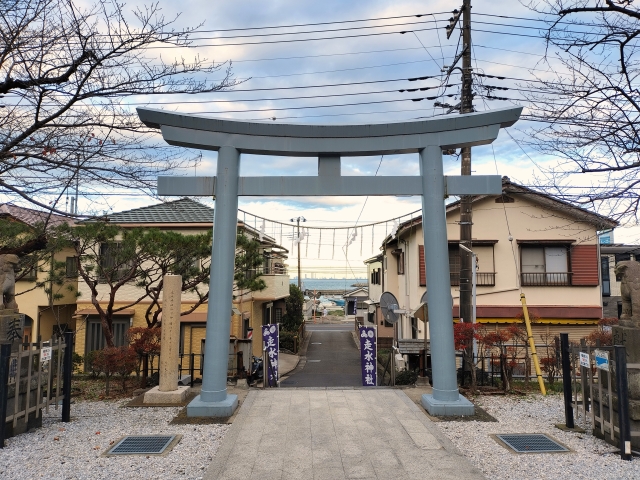
Housui-jinja Shrine is an open shrine that can be visited all day long. Worshipping at this sacred place where ancient legends live on will surely touch your heart deeply.
Worship Etiquette and Manners
The manner of worship at Sosui Shrine is the same as at most Shinto shrines. First, bow before passing through the torii gate and walk down the approach to the shrine, avoiding the center of the path. After purifying your hands and mouth at the hand- and mouth-wash basin, proceed to the main shrine building. The spring water in the hand-watering fountain is fresh water containing minerals that gushes out from a depth of 30 m. It is said to have gushed out in this area over a long period of time from Mt. By purifying yourself with this pure water, you can approach the shrine with a more sacred feeling.
In front of the main shrine, visitors worship in the manner of “Ni-hai Ni-hatte Ichi-hai” (two beats for one worship). Let us pray to the couple deity of Nihonmuson and Otachibana Ehime-no-Mikoto with feelings of gratitude and wishes. It is said that you will have a more profound experience if you worship while thinking of the spirit of devotion and love of the deity, especially of the spirit of devotion and love of the deity, Otachibana Ehime-no-Mikoto.
Please take care for your safety when going up and down the stairs. It is said that the stone steps represent the hardships suffered by the Princess Otsuchibana Ehime-no-Mikoto, and it is said that by carefully climbing the steps step by step, you will receive the blessing of increased female power.
Annual & Seasonal Events
The annual festival of Hashimizu Shrine is held on October 15. On this day, the local community gathers for this important event to carry on the shrine’s history and traditions. As a beloved local shrine, the summer festival is also held on a grand scale and attracts many worshippers.
During the cherry blossom season, the shrine grounds are decorated with beautiful cherry blossoms, making it a popular spot for cherry blossom viewing. In this day and age when there are more cherry blossom viewing spots, the shrine is not that crowded even during the cherry blossom season, and Housui-jinja Shrine can be said to be one of the best cherry blossom viewing spots in Yokosuka. Being able to visit the shrine while enjoying the cherry blossoms in a quiet environment is a unique attraction of Hashimizu Shrine.
Prayers for maritime safety and traffic safety are held throughout the year, and many people involved in the fishing and shipping industries visit the shrine. We recommend that you contact the shrine in advance for a detailed schedule of events.
Red Seal and Good Luck Charm Information
The red seal consists of a simple red seal with the characters “Sagamikuni Hashimizu” and “Hashimizu Shrine” stamped on it. It is popular among many visitors as a red seal with the dignity of a historical shrine.
An original red seal book is also available in two colors, navy blue and pink, with cherry blossoms on the front and Otachibana Ehime throwing herself into the sea on the back. These special red seal books, beautifully designed with the story of the Princess Otokachibana, are highly appreciated as a unique souvenir of Sosui Shrine.
The shrine also offers amulets for maritime safety, traffic safety, and female empowerment, among others, all of which are related to the deities of the shrine. In particular, amulets associated with the deity Otobachibana Ehime-no-mikoto are popular among those who wish to become truly feminine.
The priest serves concurrently at Kano Shrine (west) and is not stationed at Hashimizu Shrine. Please contact Kano Shrine (West) for information on prayer, purification, etc. It is also recommended to check in advance about the granting of red seals and amulets.
Access and use information
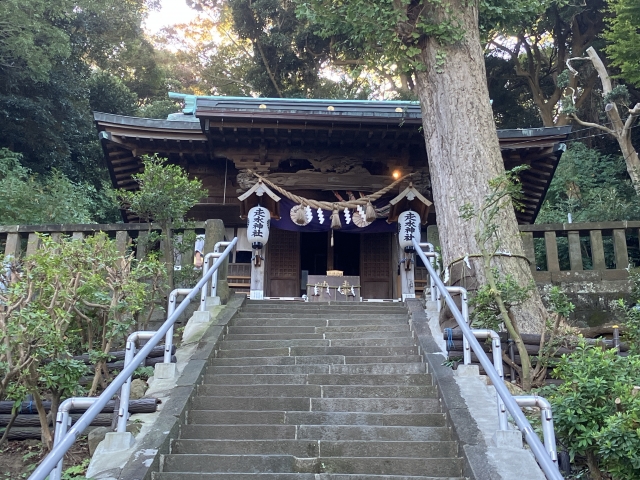
Hashimizu Shrine is a well-known tourist attraction in Yokosuka City, and is conveniently located for access by public transportation. It provides an environment where visitors can worship while enjoying beautiful ocean views.
Transportation Access
Access by train or bus Take a bus bound for Kannonzaki from Keikyu Umabori Kaigan Station (about 8 minutes) or a bus bound for Kannonzaki from JR Yokosuka Station (about 20 minutes), both getting off at the Sosui Shrine stop. It is very close to the shrine from the bus stop, and you will not get lost.
Access by car: Exit Yokohama-Yokosuka Road at the Umabori Kaigan Interchange, turn right toward Kannonzaki, and turn right at the Family Mart before the bus stop “Runsui Jinja” (Family Mart). Follow the signs for Kannonzaki for a smooth arrival.
The shrine is close to the Yokosuka Art Museum, about a 10-minute walk from the museum, so we recommend that you take the route of stopping by on your way to or from the museum. The location of the shrine is one of its charms, allowing visitors to enjoy visiting the shrine in conjunction with sightseeing.
<Address> 2-12-5 Hashimizu, Yokosuka-shi, Kanagawa 239-0811
Hours of Admission, Fees, and Parking Information
Hours of visitation
The shrine is open to visitors all day long, and the shrine office is open from 9:00 am to 3:00 pm. As a shrine that is open to visitors at any time of the day, it can be visited early in the morning or in the quiet of the evening.
Worship Fees
There is no charge to visit the shrine. No special fee is required to walk around or visit the shrine grounds. There is a suggested fee for each of the gifts, such as red seals and amulets.
Parking Information
The shrine has a parking lot for visitors, and it is possible to visit the shrine by private car. However, public transportation is recommended during cherry blossom season and events such as the annual festival, when crowds are expected.
Other Visitor Information
Please be sure to wear comfortable shoes for walking as there are slopes and stone steps around the shrine. Another attraction of the shrine is that it is located on a hill with a panoramic view of the sea, which makes it a wonderful place to take pictures. We recommend that you bring a camera to capture the beautiful scenery as well as the memories of your visit to the shrine.
Reference sites
Sosui-jinja Shrine Official Website: http://www12.plala.or.jp/hasirimizujinjya/
Kanagawa Prefectural Shinto Shrine Office: https://www.kanagawa-jinja.or.jp/shrine/1205065-000/
Yokosuka City Tourism Information: https://www.cocoyoko.net/spot/hasirimizu-z.html


